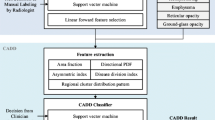Abstract
Emphysema is a common chronic respiratory disorder characterised by the destruction of lung tissue. It is a progressive disease where the early stages are characterised by a diffuse appearance of small air spaces, and later stages exhibit large air spaces called bullae. A bullous region is a sharply demarcated region of emphysema. In this paper, it is shown that an automated texture-based system based on co-training is capable of achieving multiple levels of emphysema extraction in high-resolution computed tomography (HRCT) images. Co-training is a semi-supervised technique used to improve classifiers that are trained with very few labelled examples using a large pool of unseen examples over two disjoint feature sets called views. It is also shown that examples labelled by experts can be incorporated within the system in an incremental manner. The results are also compared against “density mask”, currently a standard approach used for emphysema detection in medical image analysis and other computerized techniques used for classification of emphysema in the literature. The new system can classify diffuse regions of emphysema starting from a bullous setting. The classifiers built at different iterations also appear to show an interesting correlation with different levels of emphysema, which deserves more exploration.









Similar content being viewed by others
Notes
The heuristic based filter was joint work with Mario Bou-Haidar. Refer to [23] for more details.
References
Kinsella M, Müller NL, Abboud RT, Morrison NJ, DyBuncio A (1990) Quantification of emphysema by computed tomography using a “density mask” program and correlation with pulmonary function tests. Chest 97:315–321
Friman O, Borga M, Lundberg M, Tylén U, Knutsson H (2002) Recognizing emphysema—a neural network approach. In: Proceedings of sixteenth international conference on pattern recognition, Quebec, Canada, pp 1–4
Heitmann KR, Kauczor H, Mildenberger P, Uthmann T, Perl J, Thelen M (1997) Automatic detection of ground glass opacities on lung HRCT using multiple neural networks. Eur Radiol 9:1463–1472
Mir H, Hanmandlu M, Tandon SN (1995) Texture analysis of CT images. IEEE Eng Med Biol Mag 14:781–786
Muslea I, Minton S, Knoblock CA (2002) Adaptive view validation: a first step towards automatic view detection. In: Proceedings of the nineteenth international conference on machine learning, Sydney, Australia, pp 443–450
Blum, Mitchell T (1998) Combining labelled and unlabelled data with co-training. In: Proceedings of the 1998 conference on computational learning theory, New York, pp 92–100
Prasad M, Sowmya A (2004) Multi-level emphysema diagnosis in HRCT lung images through robust multi-view and meta-learning. In: Asian Conference on Computer Vision, Jeju, S. Korea, pp 937–942
Prasad M, Sowmya A (2004) Multi-level emphysema diagnosis of HRCT lung images in an incremental framework. In: Proc SPIE Med Imaging, San Diego, USA, vol 5370, pp 42–50
Raskutti B, Ferra H, Kowalczyk A (2002) Combining clustering and co-training to enhance text classification using unlabelled data. In: Proceedings of the eighth international conference on knowledge discovery and data mining, Canada, pp 620–625
Zelikovitz S, Hirsh H (2001) Using LSI for text classification in the presence of background text. In: Proceedings of the tenth international conference on information and knowledge management. Atlanta, GA, pp 113–118
Muslea I, Minton S, Knoblock CA (2002) Active + semi-supervised learning = robust multi-view learning. In: Proceedings of the nineteenth international conference on machine learning, Sydney, Australia, pp 435–442
Kushmerick N, Johnston E, McGuinness S (2001) Information extraction by text classification. IJCAI-01 Workshop on Adaptive Text Extraction and Mining, Seattle, Washington
Nahm U, Mooney R (2000) A mutually beneficial integration of data mining and information extraction. In: Proc Seventeenth Nat Conf Artif Intell, Austin, TX, pp 627–632
Chiu PT, Sowmya A (2001) Lung boundary detection and low level feature extraction and analysis from HRCT images. VISIM: Information Retrieval and Exploration of Large Medical Image Collections, Utrecht, Netherlands
Muslea I (2002) Active learning with multiple views. Dissertation
Baum EB, Lang KE (1991) Constructing hidden units using examples and queries. In: Lippmann RP et al. (eds) Advances in neural information processing systems. Morgan Kaufmann, San Mateo, pp 904–910
Witten IH, Frank E (1999) Data mining: practical machine learning tools and techniques with Java implementations. Morgan Laufmann, San Fransisco
Milton JS, Arnold JC (1995) Introduction to probability and statistics, principles and applications for engineering and the computing sciences, 3rd edn, McGraw-Hill International, New York
Mitchell T (1997) Machine learning. McGraw Hill, New York
Quinlan JR (1986) Induction of decision trees. Mach learn 1:81–106
Nigam K, McCallum A, Thrun S, Mitchell T (2000) Text classification from labelled and unlabelled documents using EM. Mach Learn 39:103–134
Bowyer K, Phillips P (1998) Overview of work in empirical evaluation of computer vision algorithms. In: Bowyer K et al. (eds) Empirical evaluation techniques in computer vision, IEEE Computer Society Press, CA, pp 1–11
Bou-Haidar M, Prasad M, Sowmya A (2004) Emphysema detection using a density mask. UNSW Computer Science and Engineering Technical Report no. UNSW-CSE-TR-0421
Uppaluri R, Hoffman E, Sonka M, Hartley P Hunninghake G, McLennan G (1999) Computer recognition of regional lung disease patterns. Am J Respir Crit Care Med 160:648–654
Prasad M, Sowmya A (2004) Multi-class unsupervised classification with label correction of HRCT lung images. In: Proceedings of international conference on intelligent sensing and information processing, Chennai, India, pp 51–55
Prasad M, Sowmya A, Koch I (2004) Feature subset selection using ICA for classifying emphysema in HRCT images. In: Proceedings of international conference on intelligent sensors, sensor networks and information processing, Melbourne, Australia, pp 515–519
Bertelli L, Cucchiara R, Paternostro G, Prati A (2006) A semi-automatic system for segmentation of cardiac M-mode images. Pattern Anal Appl 9:293–306
Acknowledgments
This research was partially supported by the Australian Research Council through a Linkage grant (2002–2004), with Medical Imaging Australasia as clinical and Philips Medical Systems as industrial partners.
Author information
Authors and Affiliations
Corresponding author
Rights and permissions
About this article
Cite this article
Prasad, M., Sowmya, A. & Wilson, P. Multi-level classification of emphysema in HRCT lung images. Pattern Anal Applic 12, 9–20 (2009). https://doi.org/10.1007/s10044-007-0093-7
Received:
Accepted:
Published:
Issue Date:
DOI: https://doi.org/10.1007/s10044-007-0093-7




